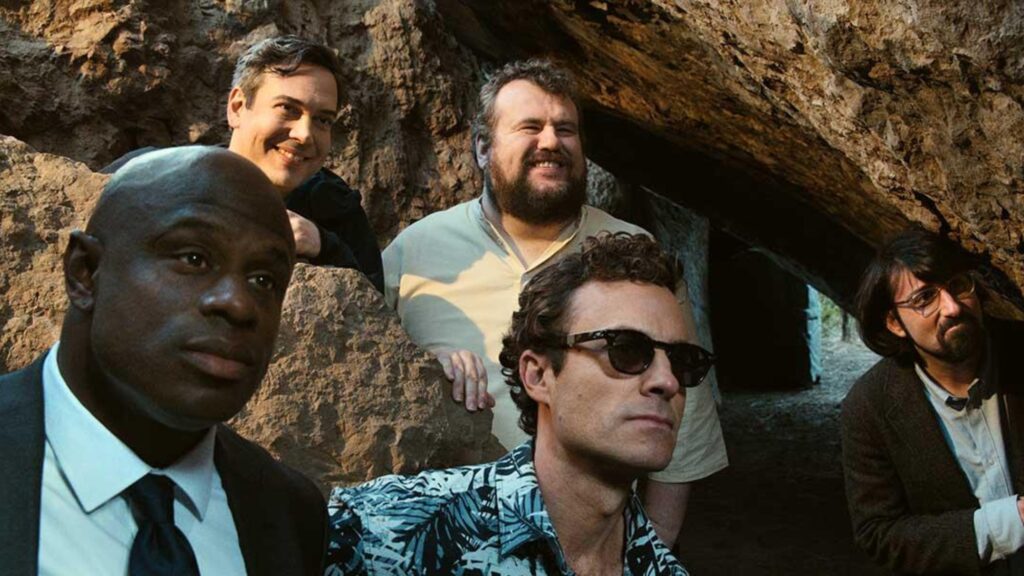Quick Facts & Context.
The Napa Boys is a 2025 American comedy film directed by Nick Corirossi and co-written with Armen Weitzman.
It had its world premiere in the Midnight Madness program at the Toronto International Film Festival (TIFF) 2025.
The premise: A group of wine-obsessed misfits (the “Napa Boys” gang) embark on a ludicrous wine-country adventure prompted by a mysterious “Sommelier” while navigating friendship, loss, and the absurdities of fandom and fandom culture.
Genre/Tone: Comedy — satirical, spoofing wine-country tropes, buddy adventure and franchise culture.
Cast & Who Carries the Film.
Cast
The Napa Boys film boasts a large ensemble cast drawn from alt-comedy and cult comic actors. Some of the credited names include:
- Armen Weitzman (one of the leads)
- Nick Corirossi (himself, director and actor)
- Sarah Ramos
- Jamar Neighbors
- Nelson Franklin
- Chloe Cherry
- Paul Rust, Riki Lindhome, Ray Wise, DJ Qualls, Kevin Smith (cameo) among many others.
If you count all major credited performers (leads + significant supporting/cameos) the number easily reaches 12-20 names. That’s a fairly large ensemble for a comedy of this kind.
Means Character.
While the film is ensemble-centric (a gang of friends on a misadventure), the narrative focal point tends to rest with two characters: Jack Jr. (Corirossi) and Miles Jr. (Weitzman). According to festival write-ups, they are the instigators of the trip and central to the story’s stakes. Of the two, one may argue that Miles Jr. (Armen Weitzman) functions as the “means character” — the character most tied to the emotional stakes of friendship, loss and adulthood (rather than just the physical misadventure). If forced to pick a single “viewpoint” character, Miles Jr. is a slightly stronger candidate. But the film intentionally diffuses protagonist status across the gang, making it more of a collective journey.
Box Collection & Commercial Context.
Because The Napa Boys premiered at TIFF 2025, and has been acquired for U.S. distribution by Magnolia Pictures (announced Oct 2025). it is still in the early stages of theatrical rollout. According to The Numbers, its domestic box-office gross is currently listed as “n/a” (not yet widely reported) for the 2026 release window.
In other words: there is no publicly disclosed large box-office figure yet. Its commercial life is likely to follow a limited theatrical release followed by streaming/ancillary sales. Given its ensemble and alt-comedy tone, its financial success will likely hinge on cult audience uptake rather than wide mainstream box office.
The Niche & Tone — What Kind of Movie Is This?
Niche
The Napa Boys fits into the niche of alt-comedy spoof / buddy misadventure with a twist of wine-country satire. It’s aimed at viewers familiar with comedic ensembles, cult humor, and those who enjoy spoofs of “travel-adventure” or “buddy road-trip” tropes (plus wine culture). It also leans into meta-franchise humor: the film presents itself as “The Napa Boys 4: The Sommelier’s Amulet,” a fictional sequel in a non-existing series, which is part of the gag.
Tone & Themes
- The tone is broad, raunchy, irreverent — reviews note “walkouts” at its TIFF screening because of certain extreme comedic set-pieces.
- Themes include friendship, nostalgia, adulthood transitions, wine culture absurdity, and the idea of legacy (the “boys” returning for one last ride). Also meta-themes: the parody of franchise fatigue, fans vs creators, and how sub-cultures elevate random things (here, Napa Valley wine).
- The film seems to appeal to viewers who enjoy non-traditional comedy, take a cult approach, and don’t expect neat narratives or pure satire.

Deep Narrative & Analysis.
Story Overview
The Napa Boys film opens with the established gang (Jack Jr., Miles Jr., Mitch, etc.) returning for one final wine-fueled adventure in Napa Valley. They are prompted by the appearance of a mysterious figure known as “The Sommelier” and a mythic “Amulet” associated with wine lore. Joined by Puck (a young fan/podcaster of the gang’s comic-book mythos), the group embarks on a journey that mixes tastings, absurd rituals, misadventures, and existential jokes about loss and nostalgia.
As they traverse vineyards, luxury tour buses, corporate tasting rooms and mystic wine caves, interpersonal tensions surface: aging, fame (in their small niche), regret, the cost of perpetual youth. The film oscillates between gross-out set-pieces (wine barrel sequences, bodily-fluids jokes) and more reflective moments about friendship and growing older. Festival reviewers say the plot is loose and the concept is more a vehicle for comedy than narrative cohesion.
Structure & Key Beats
- Act I – Re-Assembly & Mission Launch: The gang re-unites, the myth of the amulet is introduced, and they commit to the final trip. Expect opening scenes of wine tasting, flashbacks, the podcast interview with Puck.
- Act II – Adventure & Chaos: They hit the road/tracks, orbit tasting rooms and vineyards, indulge, mess up, revel. The Sommelier appears. Comedy set-pieces escalate. Relationships strain: old rivalries, unresolved issues.
- Act III – Reflection & Aftermath: The mission (to locate/own the amulet, assert their legacy) collides with real feelings: of aging, of what the wine trip actually means. The film ends with both absurdity and a little heart: the wine journey becomes a metaphor for their lives. While the narrative may not tie every thread, the emotional core is revealed.
What Works
- Ambitious and unusual concept. The idea of spoofing wine-country tourism and buddy adventure in one film is fresh. The film challenges the familiar buddy-road-trip genre by adding wine mythology, nostalgia and adult messiness.
- Ensemble chemistry & alt-comedy talent. The cast’s background in alternative comedy (Weitzman, Corirossi, Jamar Neighbors) gives the film an off-beat energy. Reviews highlight the “laughs kept coming.”
- Meta-franchise gag. Presenting itself as “entry #4” of a fictitious franchise is a smart comedic twist: it satirizes sequel culture and invites a cult audience to play along.
- Wine-culture specificity. For viewers who know wine country, vineyard jokes, tasting-room weirdness, the “IH8MERLOT” vanity-plate humor, the film offers insider-ish jokes.
What Doesn’t Land For Everyone
- Loose narrative & shallow stakes. Some critics found the film lacking in cohesive storytelling. One review says: “it really never resolved into a cohesive piece or nailed down what it was trying to convey.”
- Tone may alienate mainstream audiences. The raunch, the absurd set-pieces (wine barrels, bodily jokes) and cult-flavored humor may not suit viewers looking for polished mainstream comedy. The SFGate review calls it “about 25 years too late” in tone.
- Box-office uncertainty. Because the film is niche and limited release, its commercial prospects are more modest; wide-release audiences may never see it in theatres.
Why The Napa Boys Matters.
- It reflects a new trend in comedy: films made for cult audiences rather than tentpole crowds. It leans into absurdity, nostalgia and culture-critique in one package.
- It shows alternative comedians and creators moving into feature film territory with their own projects.
- For wine-country tourism, vineyard culture and the critique of upper-middle-class leisure, the film offers a quirky mirror.
- It illustrates how festivals like TIFF’s Midnight Madness continue to platform films that feel edgy, weird and polarising — and how distribution deals (Magnolia acquiring US rights) show there is demand for that kind of cinema.
Final Verdict — Who Should See It, And Why.
If you enjoy films that are weird, loud, off-kilter, filled with alt-comedy actors, and you’re at least somewhat familiar with wine-country culture, The Napa Boys is a fun ride. It’s probably best experienced in a communal screening (festival, midnight showing) where the jokes land with the energy of an audience.
If you prefer tight plot structure, high production polish, relatable tone and mainstream laughs, this film might feel uneven or too niche. The film rewards viewers who lean into its oddities.
In short: The Napa Boys is a cult-comedy in the making. Its strengths are its concept, its humor, its cast; its weaknesses are its narrative looseness and niche appeal. But for the right audience — wine fans, comedy nerds, alternative cinema lovers — it’s a memorable one.





